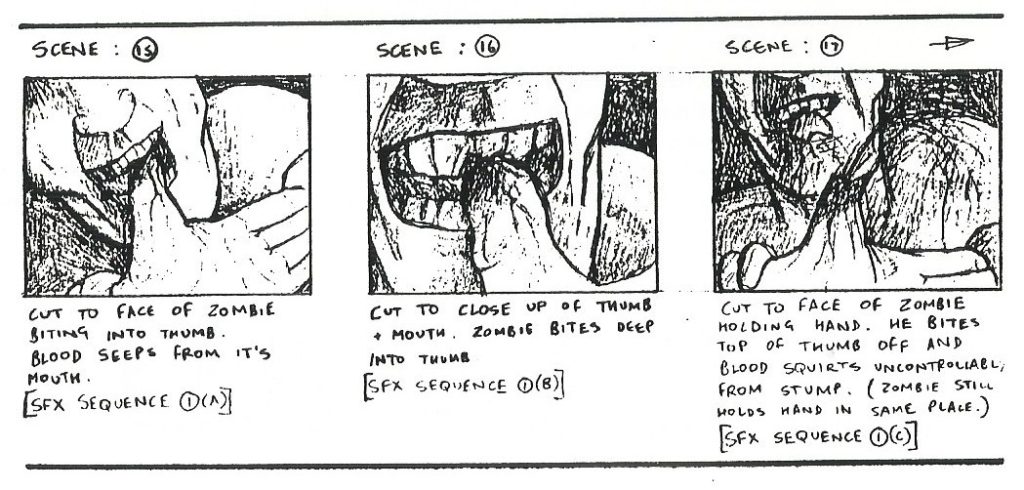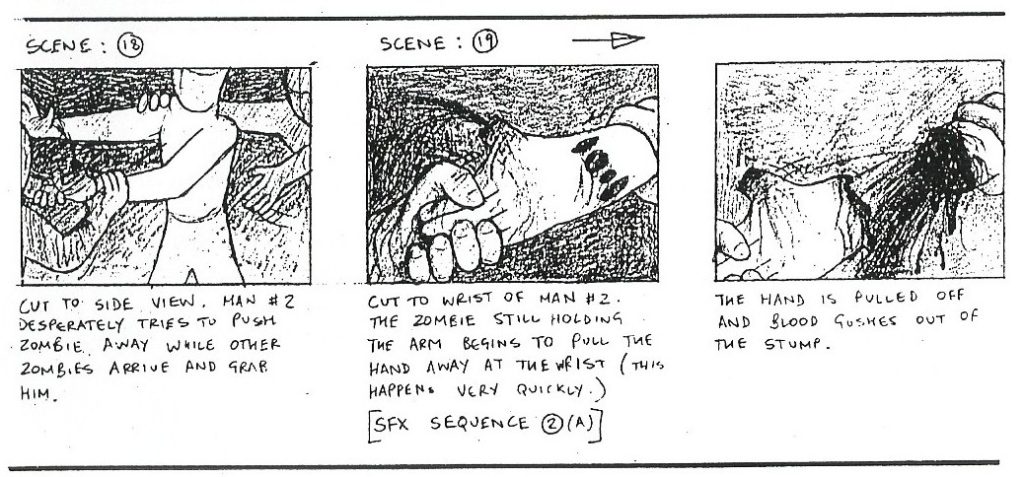Back From the Dead
The British film industry is not in a healthy state. Few films are wholly home-grown, and there’s a tendency to pander to the American market, producing costume dramas, or, even worse, to Channel 4, by making isn’t-Thatcher’s-Britain-shitty films i.e. ‘Letter to Brezhnev’, ‘My Beautiful Laundrette’, etc. Did Hammer die in vain?
Not quite. Keeping alive the spirit nowadays are stubborn individuals who make films on minimal budgets, replacing money with ingenuity, imagination and plenty of red food colouring. ‘Back From the Dead’ is one such short film, by Paul Mallinson. The film takes place in Rochdale: round about ten minutes long, it’s a mini-zombie pic – two men are attacked by a group of the living dead, who kill and dismember one of the men and drive the other into a multi-storey car park. He is eventually tracked down and also killed, but when day-break comes, his eyes suddenly open, and he too is back from the dead.
I asked Paul Mallinson to discuss some of the joys, perils and troubles of low budget film-making, starting with the obvious question :
TC: How much did it cost?
Paul Mallinson: Altogether, I’d say round about £200 – that covered just about everything. A large proportion of the money was used on Super 8mm film, which is £6 for 3½ minutes, and lighting; we rented a powerful (and noisy!) generator and halogen floodlamps. Other money was spent on blood ingredients, editing tabs (which are very expensive), plaster of paris, make-up and fuel for transport and the generator. It also cost about £15 to transfer the final cut to video, which I wasn’t too pleased about, quality-wise. My Dad lent me all the money to make the film with [which is how John Waters started, too! Ed], and I worked to pay it off at a later date.

TC: Which came first, the locations or the story?
PM: I chose the locations for practical purposes – I didn’t fancy building any sound sets! I’d been around the large car park in Doncaster quite a lot an envisaged a few good ideas and thought to myself “This would make a good, atmospheric location for a film”.
TC: Did you have much hassle getting permission to use places?
PM: The main problem was all the bloody red tape to go through to get permission to use the council car-park, Eventually, they gave the go-ahead on the condition we didn’t go throwing dead bodies from the top storey! We also had to inform the local police of our activities so that we didn’t get arrested mid-shoot.
TC: Presumably, the next stage was the script.
PM: There was no ‘script’ as such, everything took the form of a storyboard which I intended to stick to as closely as possible. In the end, I’d say we stuck to it for about 80% of the way, but sometimes we had to improvise due to some problem or another.
TC: You didn’t shoot things in the order of the storyboard – how did you work out what should be shot when?
PM: After I’d drawn the storyboard, I then had to estimate how long the whole thing would take to shoot (five nights), and I broke all the scenes down into separate sections and allocated them to the correct day for shooting i.e. the scenes where I needed lots of zombies were shot on the Tuesday, the special FX scenes were left until the last two days and so on. The timescale I’d set was about right, although there were days when we didn’t finish until 3 or 4 in the morning and others where we finished at 11 o’clock. apart from that, I was amazed at how everything seemed to slot-together nicely.
TC: How many of the scenes worked first time?
PM: Most of it was one-take material, but there were a few scenes we had to re-take. The scene where Man #1 runs up to the camera then stops and looks up took about five tries. The first attempt was unsatisfactory so we tried again – this time it was even worse, the nearby pub was emptying and a few pissed-up ‘ladies’ kept walking in front of the camera! Some scenes I shot a few times so that I could choose the best one for the final cut.

TC: What about continuity?
PM: I tried to keep an eye on the continuity and for most of the scenes everything was fine but the scene where Man #1 bumps into Man #3 in the car park was shot in bits on separate days. On the first day, Jon (Man #3) arrived in a yellow T-shirt, on the next day he wore a white T-shirt by accident – I didn’t notice this until I edited the scene together, which meant I had to reshoot the scene some three weeks after all the shooting had finished!
TC: Did you have have many serious problems?
PM: Problems – that’s a good one! Where should I start? We were plagued with some problem or other during the whole five day shoot i.e. actors arriving late, FX not going quite so smoothly, stopping the actors from laughing while filming a scene. The first near disaster happened before we began shooting – I was fiddling with the camera on the tripod when it suddenly fell off onto the concrete; luckily, it was okay. The second, and biggest, problem was lighting. Even though we had very powerful floodlamps and three cars on full-beam lighting up the place, the light-meter inside the camera still insisted there wasn’t enough light. We carried on shooting regardless – we’d gone too far to risk calling it off. Again, we were lucky, as everything came out okay. When I eventually had the final cut transferred to video, I wasn’t totally happy because some scenes came out too dark – I should have sent it back to get redone, but never got round to it. I could go on for ages about the problems but you get the picture!
TC: You added the titles and music to the video tape, didn’t you?
PM: I did all the titles myself on my Atari ST computer. I hand drew most of the lettering, slotted them all together with an animation program and transferred them to video. The last thing was the music – originally, I planned to make a proper soundtrack but decided against this due to lack of time. I chose Pink Floyd’s ‘Atom Heart Mother’ because it seemed to fit in quite well. Most people seemed to like it but I think I could have done better.

TC: Why did you use the bottom end of the film range rather than video?
PM: I prefer film, even Super 8, to video for quite a few reasons. Firstly, with video, there’s very little atmosphere – the medium doesn’t seem to ‘distance’ the viewer enough from what they’re watching, it’s too much like being there which, I think, is not a good position for a film to be in. Also, the video medium flattens things out too much, reducing the feeling of depth. I found Super 8 a very worthwhile alternative, because it captures the atmosphere quite well, is easier to use and gives the whole thing a grainier, sleazier look that I quite liked. I’ve used video and although I’d hate to make a film with it, it does have it’s advantages and can be very effective.
TC: With the benefit of hindsight, would you do anything differently?
PM: If I could do it again, I’d definitely need a better camera for better results. I’d leave all the scenes, etc as they are but maybe try a few more, different camera angles. I’d also try and get more help than I had with my first attempt!
Next up for Paul is a series of 4 or 5 short Super 8 films, located in a range of places – the locations have been found and the storyboards are beginning to take shape. Once again, his father will be offering the initial finance but there’s some distribution planned for this one, through a European company specialising in off-beat movies. The only problem, says Paul, is finding the time to make it, but he’s sure of one thing – it’ll be a million times better, even than ‘Back From the Dead’!!
